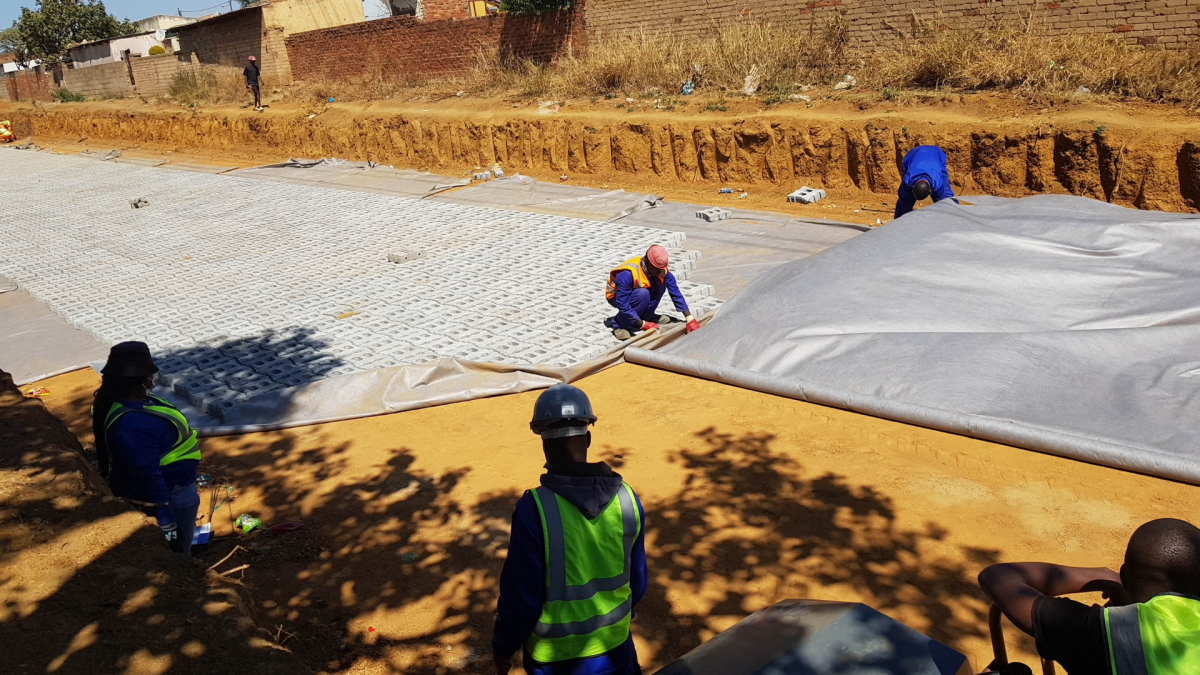
Supplied by Armorflex
Technicrete’s internationally licensed Armorflex Erosion Control System was selected for upgrades to major stormwater systems currently underway in Mamelodi Extensions 4 and 5 north-east of Pretoria. The project, undertaken by Tefla, was awarded by the City of Tshwane Metropolitan Municipality and Armorflex 140 selected as the product of choice by the Engineers due to its fit for purpose, flexibility (during installation and long term) and labour creation through ease of installation.
Based on a trapezoidal channel analysis of water volumes and velocity, Armorflex 140 was selected as the best system to install for the gradual channel to be constructed. The area has been recognised as a frequently water logged area, with large volumes of slow moving water. It was hence determined that although there is a high volume of water, the expected flow velocity is low and hence Armorflex 140 blocks would suffice as opposed to requiring the heavier 180 blocks used to offset higher velocities.
Thatho Moruke, Site Manager for Tefla, commented “The Armorflex 140 system’s flexibility is in its ability to conform with ground contours. It settles without cracking and requires limited ground preparation. When installed and anchored correctly the system offers a superior lifespan with minimum maintenance required”.
“Part of the contractual requirement was to outsource 30% of the work to workers from the local community. Armorflex’s easy installation enabled us to meet this requirement with training and some supervision, thereby adding skills to the local building labour force” Moruke said.
Before laying Armorflex blocks, the channel must first be roughly profiled to form the trapezoidal shape with dimensions approximate to that of the final design. This insitu area must be suitably compacted before placing a thin layer of river sand type material used to get final levels and clear, straight lines without any highs or lows. Obstructions, such as roots and projecting stones must be removed prior to placement of the river sand “bedding” layer as poor preparation will be reflected in the finished surface and leave high corners that will create friction points and turbulence in the flowing water. “This is an important factor,” reiterated Justin Kretzmar, Technical Sales & New Product Development Engineer at Technicrete.
He added, “The channel profile must be level in order for the water to flow smoothly and the blocks correctly interlocked in order for the Armorflex system to stay together and resist uplift of individual blocks”.
“A geotextile (woven or non-woven) is then placed on top of the levelled river sand layer. This must extend wider than the block width of the channel and must be continuous (or overlapped) along the length of channel. It is imperative that the geotextile extends into the embankment and is anchored and protected against water ingress below this layer. When flowing water gets under the geofabric, the channel has started to fail and large sections could be washed away” continued Kretzmar.
Another feature of Armorflex, specifically relevant to this project is the capacity for water to flow vertically up or down through the openings in the blocks. Accordingly, the high levels of ground water in this area will be able to seep up, through the block voids and into the channel where it will flow away. The geofabric resists migration of bedding sand when water flows up and block infill sand when water flows down, ensuring continued structural integrity of the layerworks.
One of the fundamental advantages of Armorflex are the small sleeve openings inside each block that run perpendicular to direction of water flow. These openings typically accommodate a 3.5 – 4.5mm galvanised steel wire, threaded through the system post installation of the blocks. This wire assists with overall stability of the system until such time as the natural vegetation can grow and take root, typically one to two rainy seasons. Should Armorflex be required installed in preassembled mats, for underwater installations like harbours, the contractor can use these openings to thread a structural polypropylene cable, strong enough to support a 6m x 2.4m mat of Armorflex during lifting and placement.
Maintenance is a simple annual process of ensuring that the vegetation growth is cut back to block level as overgrowth will cause settlement of silt which then spirals into larger islands of vegetation and silt, eventually blocking free flow dynamics within the Channel. It is important to note that the vegetation must not be removed, just cut down as the roots assist to lock the blocks to the channel bed.
Kretzmar added “For this project, with steep vertical sides to the channel, Technicrete’s earth retaining Florawall blocks have been proposed for placement on top of the edge blocks to protect the embankment from eroding when stormwater volumes exceed base flow of the channel. Florawall is a versatile block as it can be filled with concrete, soil or vegetation to improve overall aesthetics to a project whilst still maintaining its earth retaining function”.
“We are very satisfied with the support from Justin and his technical team, who were on site ensuring that all blocks were laid correctly and that the channel profile and levels were at the required ‘smoothness’. The delivery scheduling from Technicrete was spot on. Not only do we now have a strong, effective and long-lasting solution in place for stormwater control, but we have also upskilled many members of the surrounding communities” concluded Moruke.
The Armorflex 140 Erosion Control System is an engineered alternative for a wide variety of erosion control and drainage projects. The matrix of open cells and projections retain soils, relieve hydrostatic pressure and provide the perfect environment for establishing natural vegetation
Armorflex is supplied palletised in loose block form for manual installation or for specialised installations, preformed into mats for mechanical installation. The result is a stable protection designed to withstand high water velocities and wave attack with a finish that is aesthetically pleasing and environmentally friendly.
Technicrete and Rocla are part of the Infrastructure Specialist Group of companies (ISG).

